CW1 Case Study: Analyzing Type 2 Diabetes in Elderly Patients
VerifiedAdded on 2022/08/19
|11
|3402
|12
Case Study
AI Summary
This case study focuses on a 72-year-old female, Pauline, diagnosed with Type 2 Diabetes, along with her husband, Jack. The essay explores the disease's impact on their lifestyle, emphasizing the need for changes to manage the condition effectively. It outlines the characteristics of Type 2 Diabetes, including its causes, symptoms, and risk factors, such as Pauline's smoking habit, sweet tooth, and weight gain. The report details various medical interventions, including medication like Metformin, and lifestyle adjustments like diet and exercise, crucial for controlling blood sugar levels. Long-term and short-term goals for managing the disease are also discussed, highlighting the importance of a balanced approach involving medication, diet, and physical activity to mitigate the adverse effects of Type 2 Diabetes and improve overall health. The case study emphasizes the importance of understanding the disease and adopting a proactive approach to treatment and management.

Management 1
Health and Social Care
Health and Social Care
Paraphrase This Document
Need a fresh take? Get an instant paraphrase of this document with our AI Paraphraser
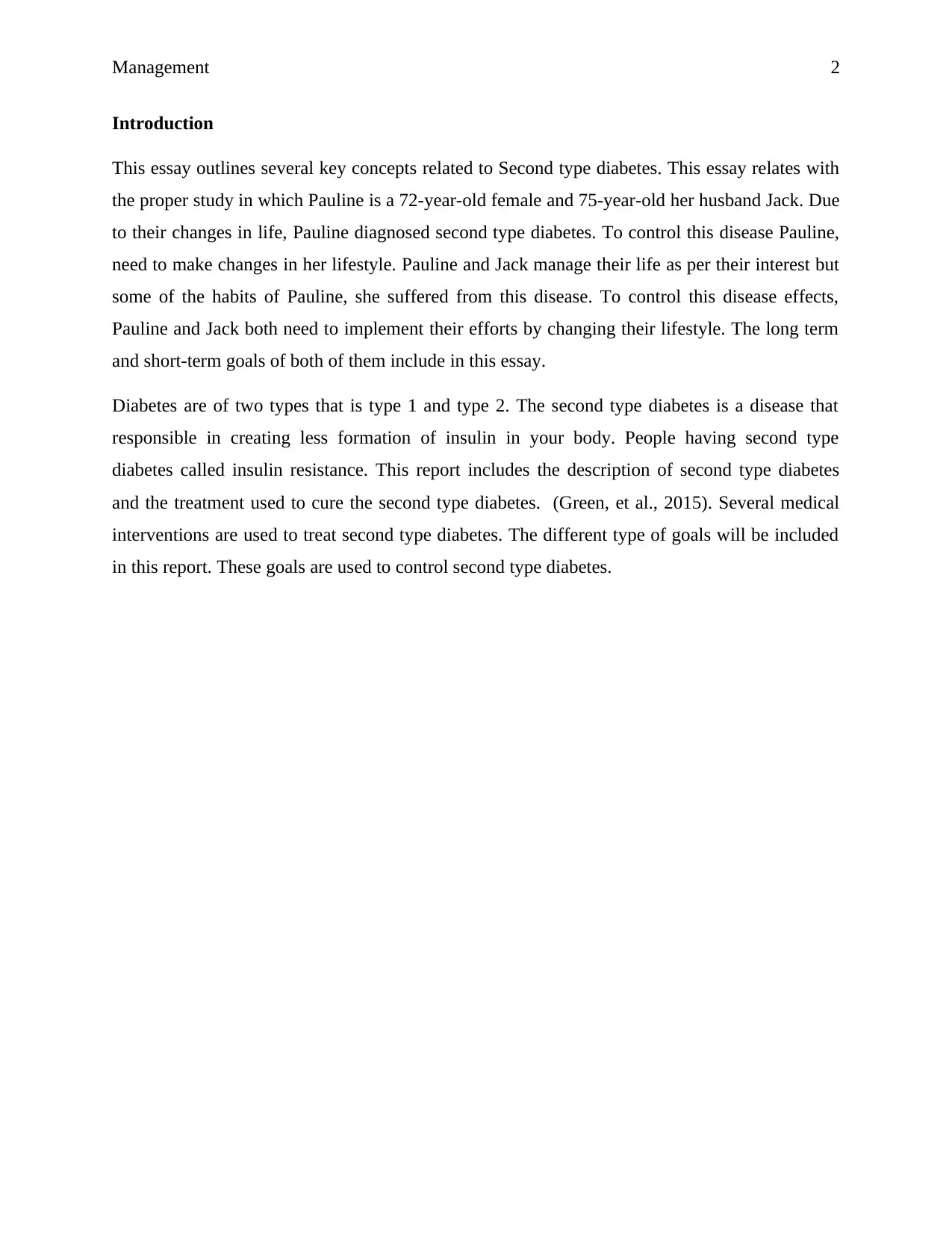
Management 2
Introduction
This essay outlines several key concepts related to Second type diabetes. This essay relates with
the proper study in which Pauline is a 72-year-old female and 75-year-old her husband Jack. Due
to their changes in life, Pauline diagnosed second type diabetes. To control this disease Pauline,
need to make changes in her lifestyle. Pauline and Jack manage their life as per their interest but
some of the habits of Pauline, she suffered from this disease. To control this disease effects,
Pauline and Jack both need to implement their efforts by changing their lifestyle. The long term
and short-term goals of both of them include in this essay.
Diabetes are of two types that is type 1 and type 2. The second type diabetes is a disease that
responsible in creating less formation of insulin in your body. People having second type
diabetes called insulin resistance. This report includes the description of second type diabetes
and the treatment used to cure the second type diabetes. (Green, et al., 2015). Several medical
interventions are used to treat second type diabetes. The different type of goals will be included
in this report. These goals are used to control second type diabetes.
Introduction
This essay outlines several key concepts related to Second type diabetes. This essay relates with
the proper study in which Pauline is a 72-year-old female and 75-year-old her husband Jack. Due
to their changes in life, Pauline diagnosed second type diabetes. To control this disease Pauline,
need to make changes in her lifestyle. Pauline and Jack manage their life as per their interest but
some of the habits of Pauline, she suffered from this disease. To control this disease effects,
Pauline and Jack both need to implement their efforts by changing their lifestyle. The long term
and short-term goals of both of them include in this essay.
Diabetes are of two types that is type 1 and type 2. The second type diabetes is a disease that
responsible in creating less formation of insulin in your body. People having second type
diabetes called insulin resistance. This report includes the description of second type diabetes
and the treatment used to cure the second type diabetes. (Green, et al., 2015). Several medical
interventions are used to treat second type diabetes. The different type of goals will be included
in this report. These goals are used to control second type diabetes.
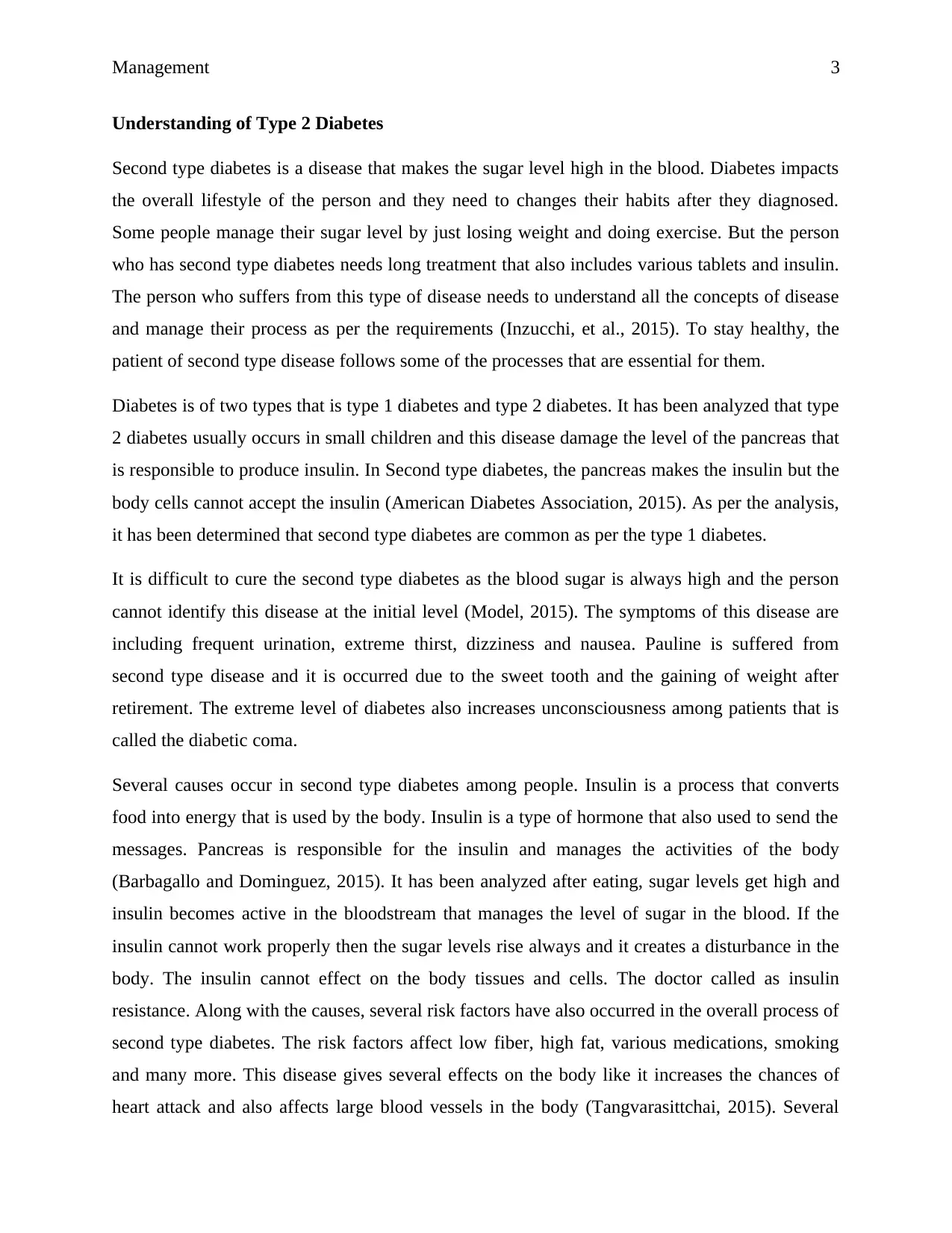
Management 3
Understanding of Type 2 Diabetes
Second type diabetes is a disease that makes the sugar level high in the blood. Diabetes impacts
the overall lifestyle of the person and they need to changes their habits after they diagnosed.
Some people manage their sugar level by just losing weight and doing exercise. But the person
who has second type diabetes needs long treatment that also includes various tablets and insulin.
The person who suffers from this type of disease needs to understand all the concepts of disease
and manage their process as per the requirements (Inzucchi, et al., 2015). To stay healthy, the
patient of second type disease follows some of the processes that are essential for them.
Diabetes is of two types that is type 1 diabetes and type 2 diabetes. It has been analyzed that type
2 diabetes usually occurs in small children and this disease damage the level of the pancreas that
is responsible to produce insulin. In Second type diabetes, the pancreas makes the insulin but the
body cells cannot accept the insulin (American Diabetes Association, 2015). As per the analysis,
it has been determined that second type diabetes are common as per the type 1 diabetes.
It is difficult to cure the second type diabetes as the blood sugar is always high and the person
cannot identify this disease at the initial level (Model, 2015). The symptoms of this disease are
including frequent urination, extreme thirst, dizziness and nausea. Pauline is suffered from
second type disease and it is occurred due to the sweet tooth and the gaining of weight after
retirement. The extreme level of diabetes also increases unconsciousness among patients that is
called the diabetic coma.
Several causes occur in second type diabetes among people. Insulin is a process that converts
food into energy that is used by the body. Insulin is a type of hormone that also used to send the
messages. Pancreas is responsible for the insulin and manages the activities of the body
(Barbagallo and Dominguez, 2015). It has been analyzed after eating, sugar levels get high and
insulin becomes active in the bloodstream that manages the level of sugar in the blood. If the
insulin cannot work properly then the sugar levels rise always and it creates a disturbance in the
body. The insulin cannot effect on the body tissues and cells. The doctor called as insulin
resistance. Along with the causes, several risk factors have also occurred in the overall process of
second type diabetes. The risk factors affect low fiber, high fat, various medications, smoking
and many more. This disease gives several effects on the body like it increases the chances of
heart attack and also affects large blood vessels in the body (Tangvarasittchai, 2015). Several
Understanding of Type 2 Diabetes
Second type diabetes is a disease that makes the sugar level high in the blood. Diabetes impacts
the overall lifestyle of the person and they need to changes their habits after they diagnosed.
Some people manage their sugar level by just losing weight and doing exercise. But the person
who has second type diabetes needs long treatment that also includes various tablets and insulin.
The person who suffers from this type of disease needs to understand all the concepts of disease
and manage their process as per the requirements (Inzucchi, et al., 2015). To stay healthy, the
patient of second type disease follows some of the processes that are essential for them.
Diabetes is of two types that is type 1 diabetes and type 2 diabetes. It has been analyzed that type
2 diabetes usually occurs in small children and this disease damage the level of the pancreas that
is responsible to produce insulin. In Second type diabetes, the pancreas makes the insulin but the
body cells cannot accept the insulin (American Diabetes Association, 2015). As per the analysis,
it has been determined that second type diabetes are common as per the type 1 diabetes.
It is difficult to cure the second type diabetes as the blood sugar is always high and the person
cannot identify this disease at the initial level (Model, 2015). The symptoms of this disease are
including frequent urination, extreme thirst, dizziness and nausea. Pauline is suffered from
second type disease and it is occurred due to the sweet tooth and the gaining of weight after
retirement. The extreme level of diabetes also increases unconsciousness among patients that is
called the diabetic coma.
Several causes occur in second type diabetes among people. Insulin is a process that converts
food into energy that is used by the body. Insulin is a type of hormone that also used to send the
messages. Pancreas is responsible for the insulin and manages the activities of the body
(Barbagallo and Dominguez, 2015). It has been analyzed after eating, sugar levels get high and
insulin becomes active in the bloodstream that manages the level of sugar in the blood. If the
insulin cannot work properly then the sugar levels rise always and it creates a disturbance in the
body. The insulin cannot effect on the body tissues and cells. The doctor called as insulin
resistance. Along with the causes, several risk factors have also occurred in the overall process of
second type diabetes. The risk factors affect low fiber, high fat, various medications, smoking
and many more. This disease gives several effects on the body like it increases the chances of
heart attack and also affects large blood vessels in the body (Tangvarasittchai, 2015). Several
⊘ This is a preview!⊘
Do you want full access?
Subscribe today to unlock all pages.

Trusted by 1+ million students worldwide
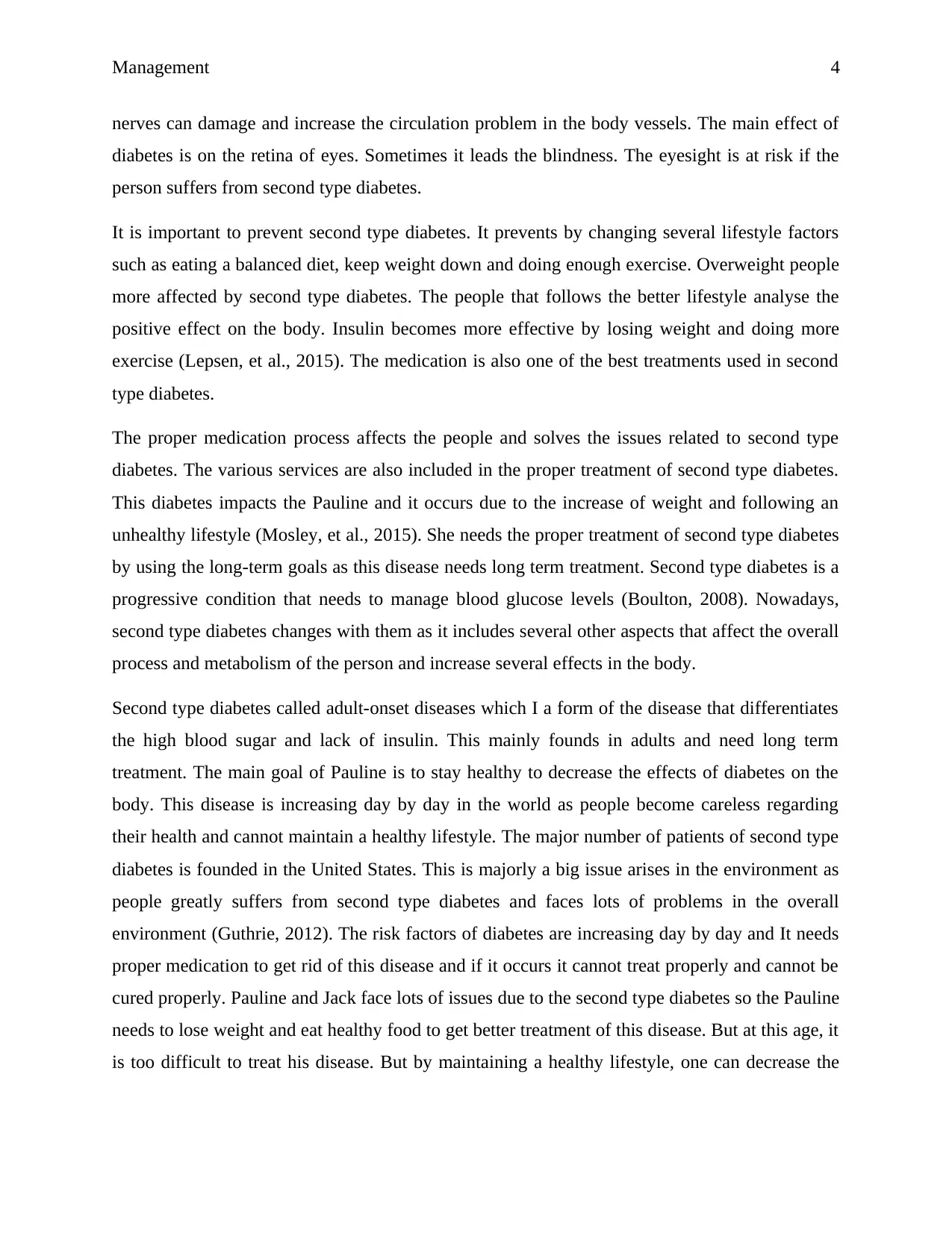
Management 4
nerves can damage and increase the circulation problem in the body vessels. The main effect of
diabetes is on the retina of eyes. Sometimes it leads the blindness. The eyesight is at risk if the
person suffers from second type diabetes.
It is important to prevent second type diabetes. It prevents by changing several lifestyle factors
such as eating a balanced diet, keep weight down and doing enough exercise. Overweight people
more affected by second type diabetes. The people that follows the better lifestyle analyse the
positive effect on the body. Insulin becomes more effective by losing weight and doing more
exercise (Lepsen, et al., 2015). The medication is also one of the best treatments used in second
type diabetes.
The proper medication process affects the people and solves the issues related to second type
diabetes. The various services are also included in the proper treatment of second type diabetes.
This diabetes impacts the Pauline and it occurs due to the increase of weight and following an
unhealthy lifestyle (Mosley, et al., 2015). She needs the proper treatment of second type diabetes
by using the long-term goals as this disease needs long term treatment. Second type diabetes is a
progressive condition that needs to manage blood glucose levels (Boulton, 2008). Nowadays,
second type diabetes changes with them as it includes several other aspects that affect the overall
process and metabolism of the person and increase several effects in the body.
Second type diabetes called adult-onset diseases which I a form of the disease that differentiates
the high blood sugar and lack of insulin. This mainly founds in adults and need long term
treatment. The main goal of Pauline is to stay healthy to decrease the effects of diabetes on the
body. This disease is increasing day by day in the world as people become careless regarding
their health and cannot maintain a healthy lifestyle. The major number of patients of second type
diabetes is founded in the United States. This is majorly a big issue arises in the environment as
people greatly suffers from second type diabetes and faces lots of problems in the overall
environment (Guthrie, 2012). The risk factors of diabetes are increasing day by day and It needs
proper medication to get rid of this disease and if it occurs it cannot treat properly and cannot be
cured properly. Pauline and Jack face lots of issues due to the second type diabetes so the Pauline
needs to lose weight and eat healthy food to get better treatment of this disease. But at this age, it
is too difficult to treat his disease. But by maintaining a healthy lifestyle, one can decrease the
nerves can damage and increase the circulation problem in the body vessels. The main effect of
diabetes is on the retina of eyes. Sometimes it leads the blindness. The eyesight is at risk if the
person suffers from second type diabetes.
It is important to prevent second type diabetes. It prevents by changing several lifestyle factors
such as eating a balanced diet, keep weight down and doing enough exercise. Overweight people
more affected by second type diabetes. The people that follows the better lifestyle analyse the
positive effect on the body. Insulin becomes more effective by losing weight and doing more
exercise (Lepsen, et al., 2015). The medication is also one of the best treatments used in second
type diabetes.
The proper medication process affects the people and solves the issues related to second type
diabetes. The various services are also included in the proper treatment of second type diabetes.
This diabetes impacts the Pauline and it occurs due to the increase of weight and following an
unhealthy lifestyle (Mosley, et al., 2015). She needs the proper treatment of second type diabetes
by using the long-term goals as this disease needs long term treatment. Second type diabetes is a
progressive condition that needs to manage blood glucose levels (Boulton, 2008). Nowadays,
second type diabetes changes with them as it includes several other aspects that affect the overall
process and metabolism of the person and increase several effects in the body.
Second type diabetes called adult-onset diseases which I a form of the disease that differentiates
the high blood sugar and lack of insulin. This mainly founds in adults and need long term
treatment. The main goal of Pauline is to stay healthy to decrease the effects of diabetes on the
body. This disease is increasing day by day in the world as people become careless regarding
their health and cannot maintain a healthy lifestyle. The major number of patients of second type
diabetes is founded in the United States. This is majorly a big issue arises in the environment as
people greatly suffers from second type diabetes and faces lots of problems in the overall
environment (Guthrie, 2012). The risk factors of diabetes are increasing day by day and It needs
proper medication to get rid of this disease and if it occurs it cannot treat properly and cannot be
cured properly. Pauline and Jack face lots of issues due to the second type diabetes so the Pauline
needs to lose weight and eat healthy food to get better treatment of this disease. But at this age, it
is too difficult to treat his disease. But by maintaining a healthy lifestyle, one can decrease the
Paraphrase This Document
Need a fresh take? Get an instant paraphrase of this document with our AI Paraphraser
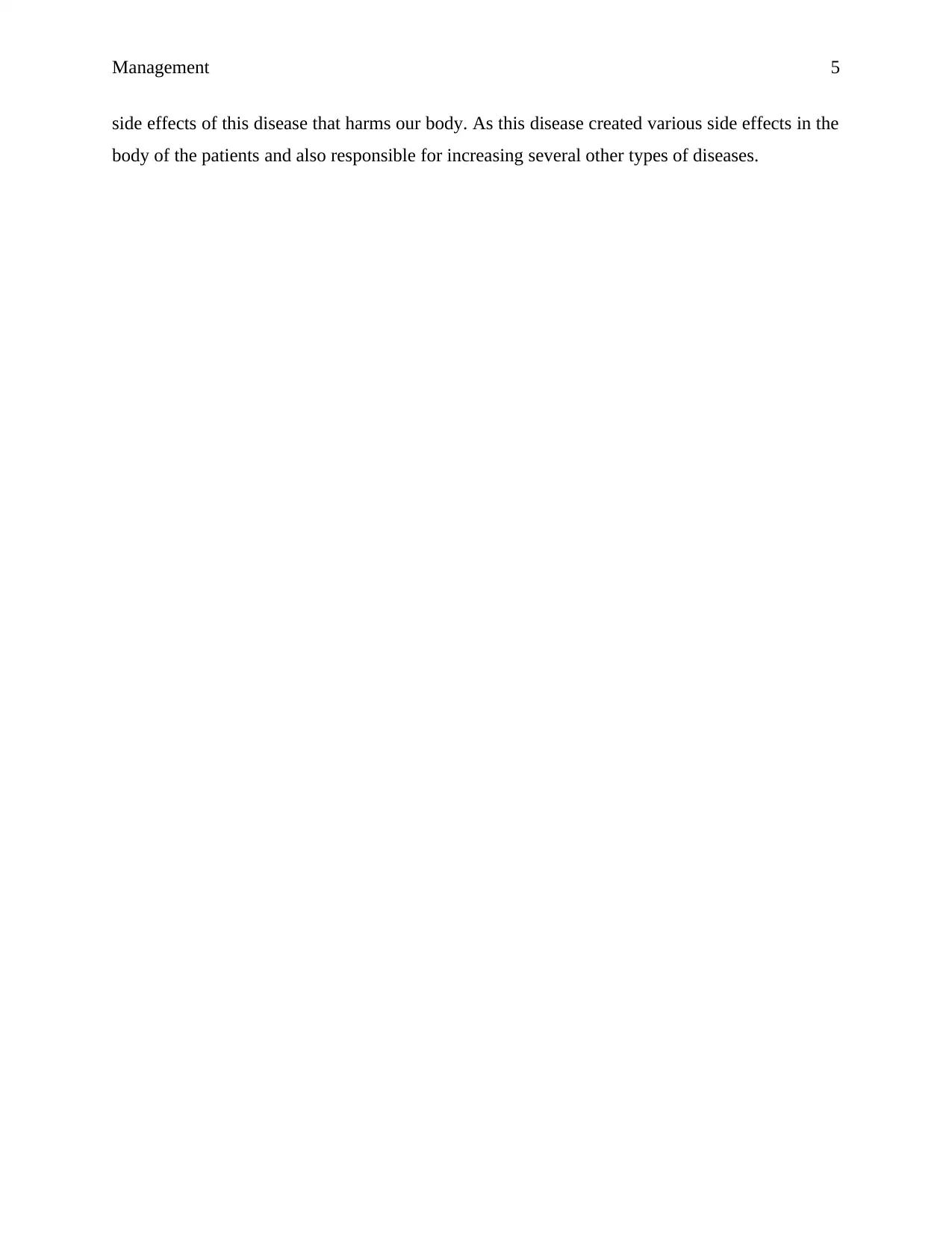
Management 5
side effects of this disease that harms our body. As this disease created various side effects in the
body of the patients and also responsible for increasing several other types of diseases.
side effects of this disease that harms our body. As this disease created various side effects in the
body of the patients and also responsible for increasing several other types of diseases.
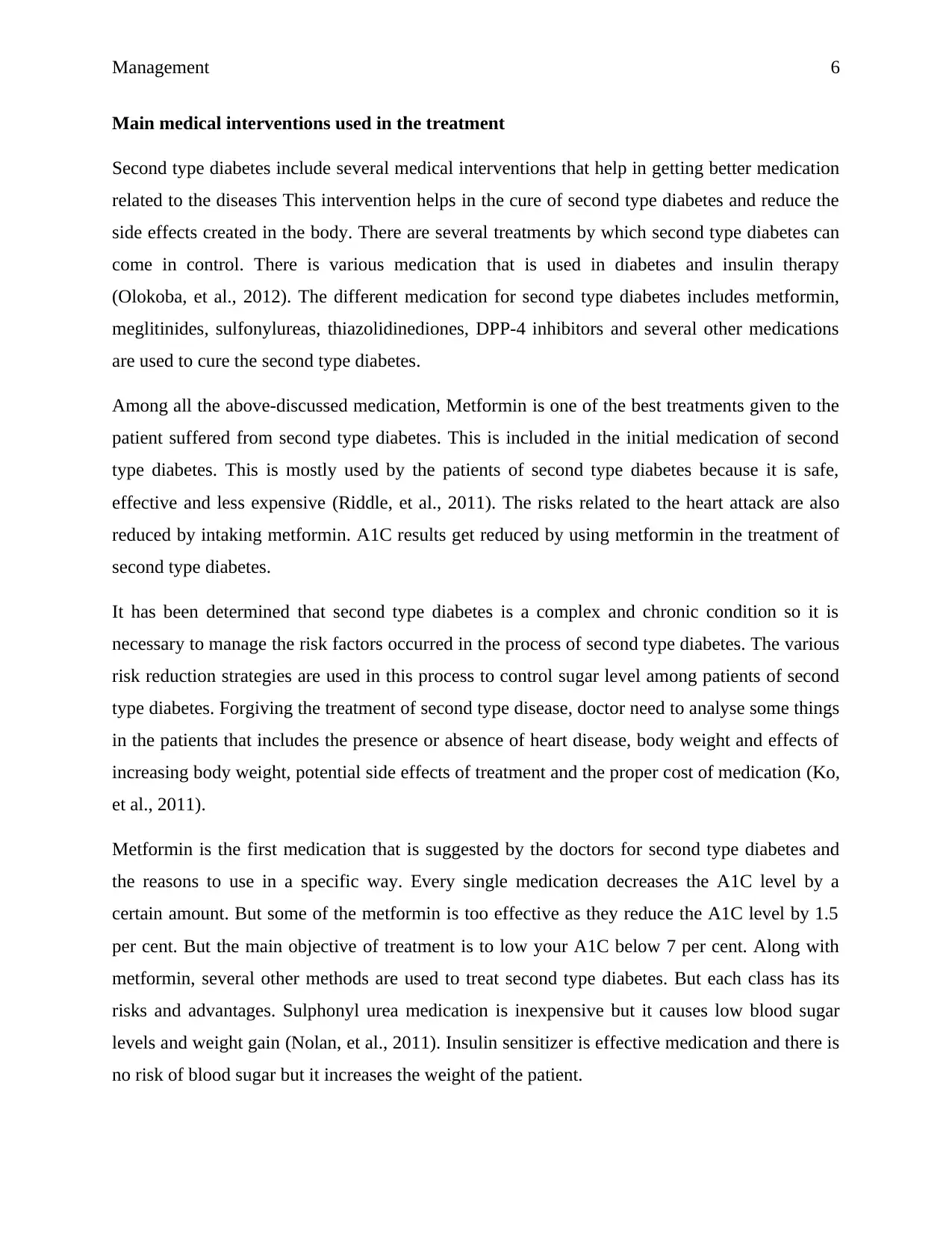
Management 6
Main medical interventions used in the treatment
Second type diabetes include several medical interventions that help in getting better medication
related to the diseases This intervention helps in the cure of second type diabetes and reduce the
side effects created in the body. There are several treatments by which second type diabetes can
come in control. There is various medication that is used in diabetes and insulin therapy
(Olokoba, et al., 2012). The different medication for second type diabetes includes metformin,
meglitinides, sulfonylureas, thiazolidinediones, DPP-4 inhibitors and several other medications
are used to cure the second type diabetes.
Among all the above-discussed medication, Metformin is one of the best treatments given to the
patient suffered from second type diabetes. This is included in the initial medication of second
type diabetes. This is mostly used by the patients of second type diabetes because it is safe,
effective and less expensive (Riddle, et al., 2011). The risks related to the heart attack are also
reduced by intaking metformin. A1C results get reduced by using metformin in the treatment of
second type diabetes.
It has been determined that second type diabetes is a complex and chronic condition so it is
necessary to manage the risk factors occurred in the process of second type diabetes. The various
risk reduction strategies are used in this process to control sugar level among patients of second
type diabetes. Forgiving the treatment of second type disease, doctor need to analyse some things
in the patients that includes the presence or absence of heart disease, body weight and effects of
increasing body weight, potential side effects of treatment and the proper cost of medication (Ko,
et al., 2011).
Metformin is the first medication that is suggested by the doctors for second type diabetes and
the reasons to use in a specific way. Every single medication decreases the A1C level by a
certain amount. But some of the metformin is too effective as they reduce the A1C level by 1.5
per cent. But the main objective of treatment is to low your A1C below 7 per cent. Along with
metformin, several other methods are used to treat second type diabetes. But each class has its
risks and advantages. Sulphonyl urea medication is inexpensive but it causes low blood sugar
levels and weight gain (Nolan, et al., 2011). Insulin sensitizer is effective medication and there is
no risk of blood sugar but it increases the weight of the patient.
Main medical interventions used in the treatment
Second type diabetes include several medical interventions that help in getting better medication
related to the diseases This intervention helps in the cure of second type diabetes and reduce the
side effects created in the body. There are several treatments by which second type diabetes can
come in control. There is various medication that is used in diabetes and insulin therapy
(Olokoba, et al., 2012). The different medication for second type diabetes includes metformin,
meglitinides, sulfonylureas, thiazolidinediones, DPP-4 inhibitors and several other medications
are used to cure the second type diabetes.
Among all the above-discussed medication, Metformin is one of the best treatments given to the
patient suffered from second type diabetes. This is included in the initial medication of second
type diabetes. This is mostly used by the patients of second type diabetes because it is safe,
effective and less expensive (Riddle, et al., 2011). The risks related to the heart attack are also
reduced by intaking metformin. A1C results get reduced by using metformin in the treatment of
second type diabetes.
It has been determined that second type diabetes is a complex and chronic condition so it is
necessary to manage the risk factors occurred in the process of second type diabetes. The various
risk reduction strategies are used in this process to control sugar level among patients of second
type diabetes. Forgiving the treatment of second type disease, doctor need to analyse some things
in the patients that includes the presence or absence of heart disease, body weight and effects of
increasing body weight, potential side effects of treatment and the proper cost of medication (Ko,
et al., 2011).
Metformin is the first medication that is suggested by the doctors for second type diabetes and
the reasons to use in a specific way. Every single medication decreases the A1C level by a
certain amount. But some of the metformin is too effective as they reduce the A1C level by 1.5
per cent. But the main objective of treatment is to low your A1C below 7 per cent. Along with
metformin, several other methods are used to treat second type diabetes. But each class has its
risks and advantages. Sulphonyl urea medication is inexpensive but it causes low blood sugar
levels and weight gain (Nolan, et al., 2011). Insulin sensitizer is effective medication and there is
no risk of blood sugar but it increases the weight of the patient.
⊘ This is a preview!⊘
Do you want full access?
Subscribe today to unlock all pages.

Trusted by 1+ million students worldwide
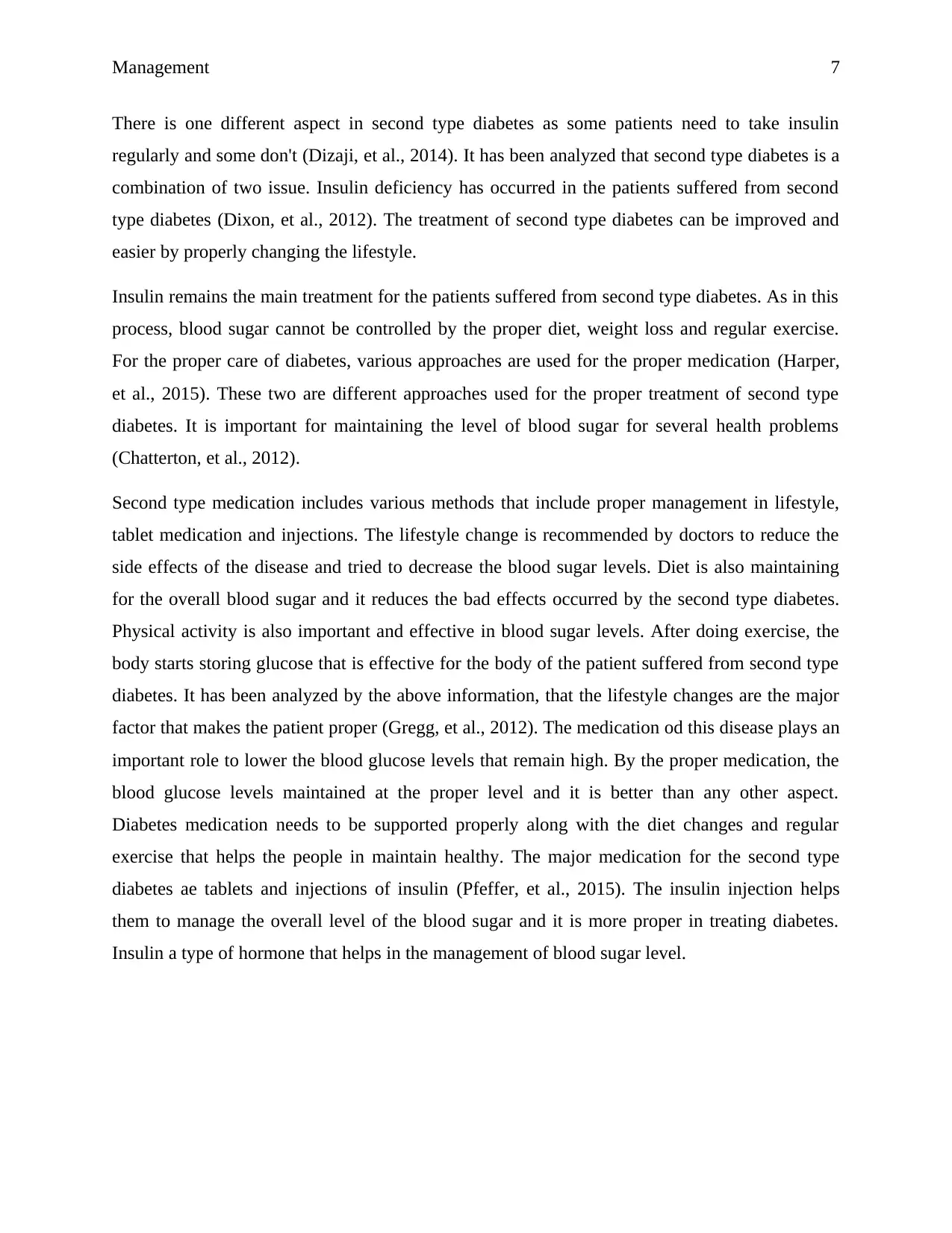
Management 7
There is one different aspect in second type diabetes as some patients need to take insulin
regularly and some don't (Dizaji, et al., 2014). It has been analyzed that second type diabetes is a
combination of two issue. Insulin deficiency has occurred in the patients suffered from second
type diabetes (Dixon, et al., 2012). The treatment of second type diabetes can be improved and
easier by properly changing the lifestyle.
Insulin remains the main treatment for the patients suffered from second type diabetes. As in this
process, blood sugar cannot be controlled by the proper diet, weight loss and regular exercise.
For the proper care of diabetes, various approaches are used for the proper medication (Harper,
et al., 2015). These two are different approaches used for the proper treatment of second type
diabetes. It is important for maintaining the level of blood sugar for several health problems
(Chatterton, et al., 2012).
Second type medication includes various methods that include proper management in lifestyle,
tablet medication and injections. The lifestyle change is recommended by doctors to reduce the
side effects of the disease and tried to decrease the blood sugar levels. Diet is also maintaining
for the overall blood sugar and it reduces the bad effects occurred by the second type diabetes.
Physical activity is also important and effective in blood sugar levels. After doing exercise, the
body starts storing glucose that is effective for the body of the patient suffered from second type
diabetes. It has been analyzed by the above information, that the lifestyle changes are the major
factor that makes the patient proper (Gregg, et al., 2012). The medication od this disease plays an
important role to lower the blood glucose levels that remain high. By the proper medication, the
blood glucose levels maintained at the proper level and it is better than any other aspect.
Diabetes medication needs to be supported properly along with the diet changes and regular
exercise that helps the people in maintain healthy. The major medication for the second type
diabetes ae tablets and injections of insulin (Pfeffer, et al., 2015). The insulin injection helps
them to manage the overall level of the blood sugar and it is more proper in treating diabetes.
Insulin a type of hormone that helps in the management of blood sugar level.
There is one different aspect in second type diabetes as some patients need to take insulin
regularly and some don't (Dizaji, et al., 2014). It has been analyzed that second type diabetes is a
combination of two issue. Insulin deficiency has occurred in the patients suffered from second
type diabetes (Dixon, et al., 2012). The treatment of second type diabetes can be improved and
easier by properly changing the lifestyle.
Insulin remains the main treatment for the patients suffered from second type diabetes. As in this
process, blood sugar cannot be controlled by the proper diet, weight loss and regular exercise.
For the proper care of diabetes, various approaches are used for the proper medication (Harper,
et al., 2015). These two are different approaches used for the proper treatment of second type
diabetes. It is important for maintaining the level of blood sugar for several health problems
(Chatterton, et al., 2012).
Second type medication includes various methods that include proper management in lifestyle,
tablet medication and injections. The lifestyle change is recommended by doctors to reduce the
side effects of the disease and tried to decrease the blood sugar levels. Diet is also maintaining
for the overall blood sugar and it reduces the bad effects occurred by the second type diabetes.
Physical activity is also important and effective in blood sugar levels. After doing exercise, the
body starts storing glucose that is effective for the body of the patient suffered from second type
diabetes. It has been analyzed by the above information, that the lifestyle changes are the major
factor that makes the patient proper (Gregg, et al., 2012). The medication od this disease plays an
important role to lower the blood glucose levels that remain high. By the proper medication, the
blood glucose levels maintained at the proper level and it is better than any other aspect.
Diabetes medication needs to be supported properly along with the diet changes and regular
exercise that helps the people in maintain healthy. The major medication for the second type
diabetes ae tablets and injections of insulin (Pfeffer, et al., 2015). The insulin injection helps
them to manage the overall level of the blood sugar and it is more proper in treating diabetes.
Insulin a type of hormone that helps in the management of blood sugar level.
Paraphrase This Document
Need a fresh take? Get an instant paraphrase of this document with our AI Paraphraser
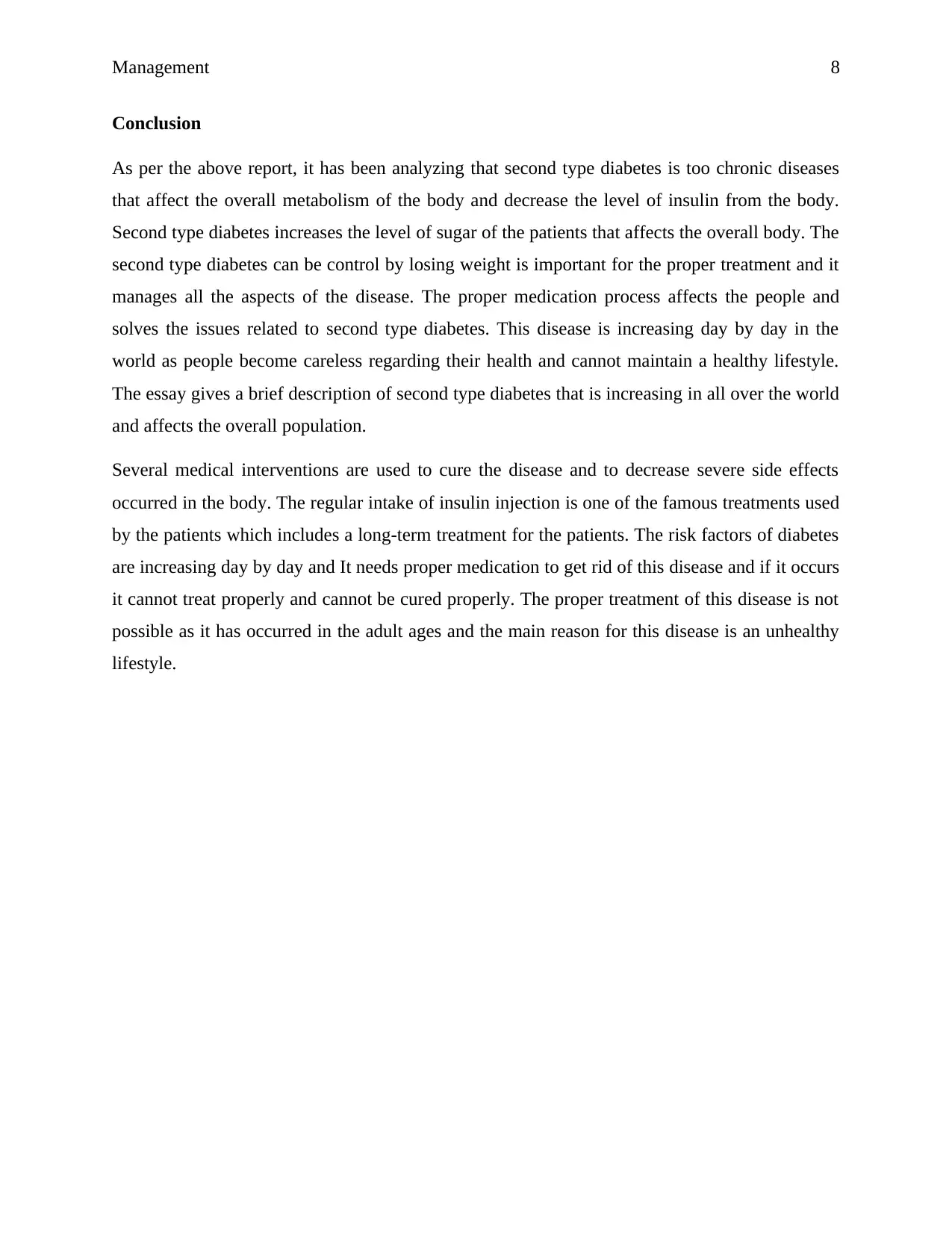
Management 8
Conclusion
As per the above report, it has been analyzing that second type diabetes is too chronic diseases
that affect the overall metabolism of the body and decrease the level of insulin from the body.
Second type diabetes increases the level of sugar of the patients that affects the overall body. The
second type diabetes can be control by losing weight is important for the proper treatment and it
manages all the aspects of the disease. The proper medication process affects the people and
solves the issues related to second type diabetes. This disease is increasing day by day in the
world as people become careless regarding their health and cannot maintain a healthy lifestyle.
The essay gives a brief description of second type diabetes that is increasing in all over the world
and affects the overall population.
Several medical interventions are used to cure the disease and to decrease severe side effects
occurred in the body. The regular intake of insulin injection is one of the famous treatments used
by the patients which includes a long-term treatment for the patients. The risk factors of diabetes
are increasing day by day and It needs proper medication to get rid of this disease and if it occurs
it cannot treat properly and cannot be cured properly. The proper treatment of this disease is not
possible as it has occurred in the adult ages and the main reason for this disease is an unhealthy
lifestyle.
Conclusion
As per the above report, it has been analyzing that second type diabetes is too chronic diseases
that affect the overall metabolism of the body and decrease the level of insulin from the body.
Second type diabetes increases the level of sugar of the patients that affects the overall body. The
second type diabetes can be control by losing weight is important for the proper treatment and it
manages all the aspects of the disease. The proper medication process affects the people and
solves the issues related to second type diabetes. This disease is increasing day by day in the
world as people become careless regarding their health and cannot maintain a healthy lifestyle.
The essay gives a brief description of second type diabetes that is increasing in all over the world
and affects the overall population.
Several medical interventions are used to cure the disease and to decrease severe side effects
occurred in the body. The regular intake of insulin injection is one of the famous treatments used
by the patients which includes a long-term treatment for the patients. The risk factors of diabetes
are increasing day by day and It needs proper medication to get rid of this disease and if it occurs
it cannot treat properly and cannot be cured properly. The proper treatment of this disease is not
possible as it has occurred in the adult ages and the main reason for this disease is an unhealthy
lifestyle.
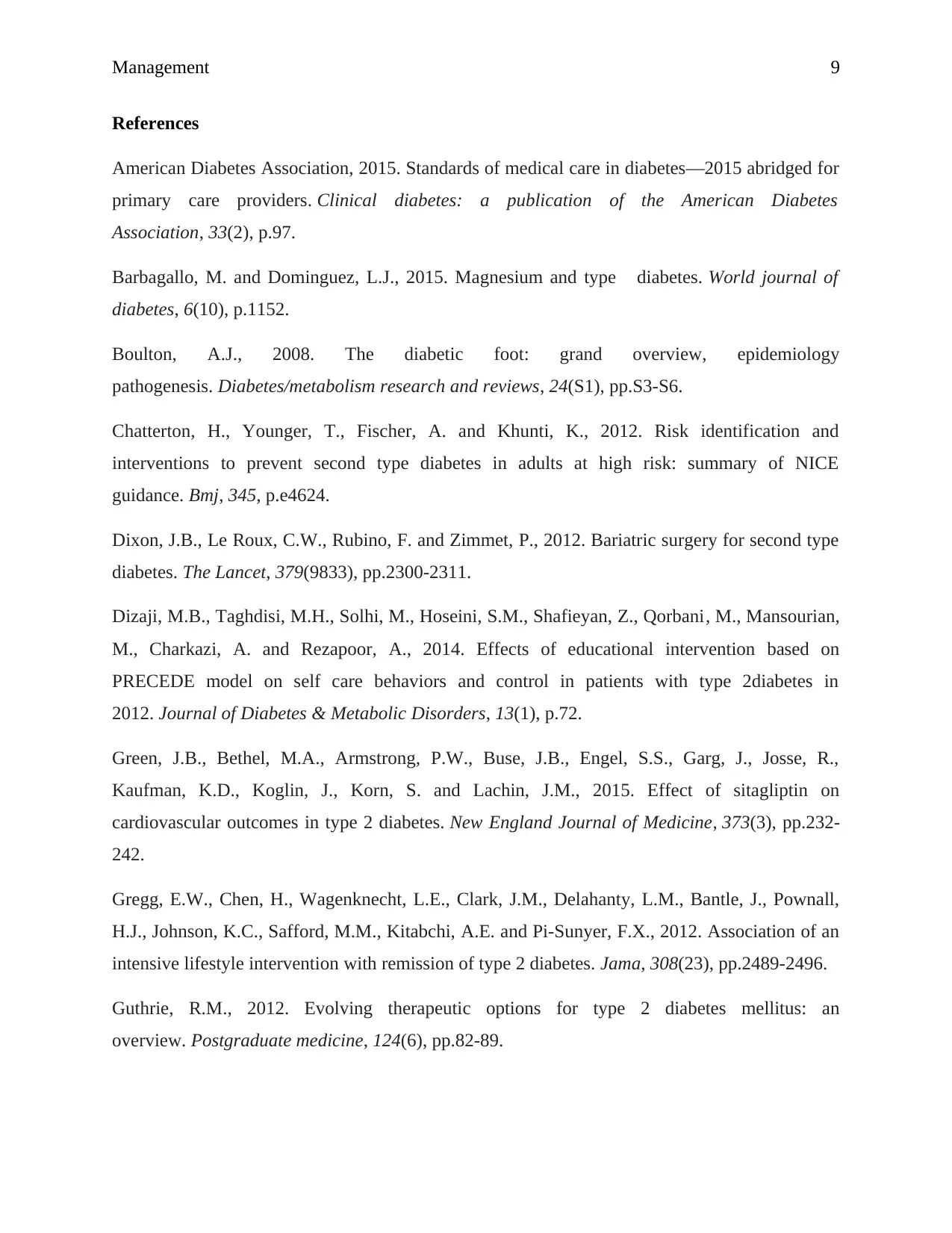
Management 9
References
American Diabetes Association, 2015. Standards of medical care in diabetes—2015 abridged for
primary care providers. Clinical diabetes: a publication of the American Diabetes
Association, 33(2), p.97.
Barbagallo, M. and Dominguez, L.J., 2015. Magnesium and type diabetes. World journal of
diabetes, 6(10), p.1152.
Boulton, A.J., 2008. The diabetic foot: grand overview, epidemiology
pathogenesis. Diabetes/metabolism research and reviews, 24(S1), pp.S3-S6.
Chatterton, H., Younger, T., Fischer, A. and Khunti, K., 2012. Risk identification and
interventions to prevent second type diabetes in adults at high risk: summary of NICE
guidance. Bmj, 345, p.e4624.
Dixon, J.B., Le Roux, C.W., Rubino, F. and Zimmet, P., 2012. Bariatric surgery for second type
diabetes. The Lancet, 379(9833), pp.2300-2311.
Dizaji, M.B., Taghdisi, M.H., Solhi, M., Hoseini, S.M., Shafieyan, Z., Qorbani, M., Mansourian,
M., Charkazi, A. and Rezapoor, A., 2014. Effects of educational intervention based on
PRECEDE model on self care behaviors and control in patients with type 2diabetes in
2012. Journal of Diabetes & Metabolic Disorders, 13(1), p.72.
Green, J.B., Bethel, M.A., Armstrong, P.W., Buse, J.B., Engel, S.S., Garg, J., Josse, R.,
Kaufman, K.D., Koglin, J., Korn, S. and Lachin, J.M., 2015. Effect of sitagliptin on
cardiovascular outcomes in type 2 diabetes. New England Journal of Medicine, 373(3), pp.232-
242.
Gregg, E.W., Chen, H., Wagenknecht, L.E., Clark, J.M., Delahanty, L.M., Bantle, J., Pownall,
H.J., Johnson, K.C., Safford, M.M., Kitabchi, A.E. and Pi-Sunyer, F.X., 2012. Association of an
intensive lifestyle intervention with remission of type 2 diabetes. Jama, 308(23), pp.2489-2496.
Guthrie, R.M., 2012. Evolving therapeutic options for type 2 diabetes mellitus: an
overview. Postgraduate medicine, 124(6), pp.82-89.
References
American Diabetes Association, 2015. Standards of medical care in diabetes—2015 abridged for
primary care providers. Clinical diabetes: a publication of the American Diabetes
Association, 33(2), p.97.
Barbagallo, M. and Dominguez, L.J., 2015. Magnesium and type diabetes. World journal of
diabetes, 6(10), p.1152.
Boulton, A.J., 2008. The diabetic foot: grand overview, epidemiology
pathogenesis. Diabetes/metabolism research and reviews, 24(S1), pp.S3-S6.
Chatterton, H., Younger, T., Fischer, A. and Khunti, K., 2012. Risk identification and
interventions to prevent second type diabetes in adults at high risk: summary of NICE
guidance. Bmj, 345, p.e4624.
Dixon, J.B., Le Roux, C.W., Rubino, F. and Zimmet, P., 2012. Bariatric surgery for second type
diabetes. The Lancet, 379(9833), pp.2300-2311.
Dizaji, M.B., Taghdisi, M.H., Solhi, M., Hoseini, S.M., Shafieyan, Z., Qorbani, M., Mansourian,
M., Charkazi, A. and Rezapoor, A., 2014. Effects of educational intervention based on
PRECEDE model on self care behaviors and control in patients with type 2diabetes in
2012. Journal of Diabetes & Metabolic Disorders, 13(1), p.72.
Green, J.B., Bethel, M.A., Armstrong, P.W., Buse, J.B., Engel, S.S., Garg, J., Josse, R.,
Kaufman, K.D., Koglin, J., Korn, S. and Lachin, J.M., 2015. Effect of sitagliptin on
cardiovascular outcomes in type 2 diabetes. New England Journal of Medicine, 373(3), pp.232-
242.
Gregg, E.W., Chen, H., Wagenknecht, L.E., Clark, J.M., Delahanty, L.M., Bantle, J., Pownall,
H.J., Johnson, K.C., Safford, M.M., Kitabchi, A.E. and Pi-Sunyer, F.X., 2012. Association of an
intensive lifestyle intervention with remission of type 2 diabetes. Jama, 308(23), pp.2489-2496.
Guthrie, R.M., 2012. Evolving therapeutic options for type 2 diabetes mellitus: an
overview. Postgraduate medicine, 124(6), pp.82-89.
⊘ This is a preview!⊘
Do you want full access?
Subscribe today to unlock all pages.

Trusted by 1+ million students worldwide
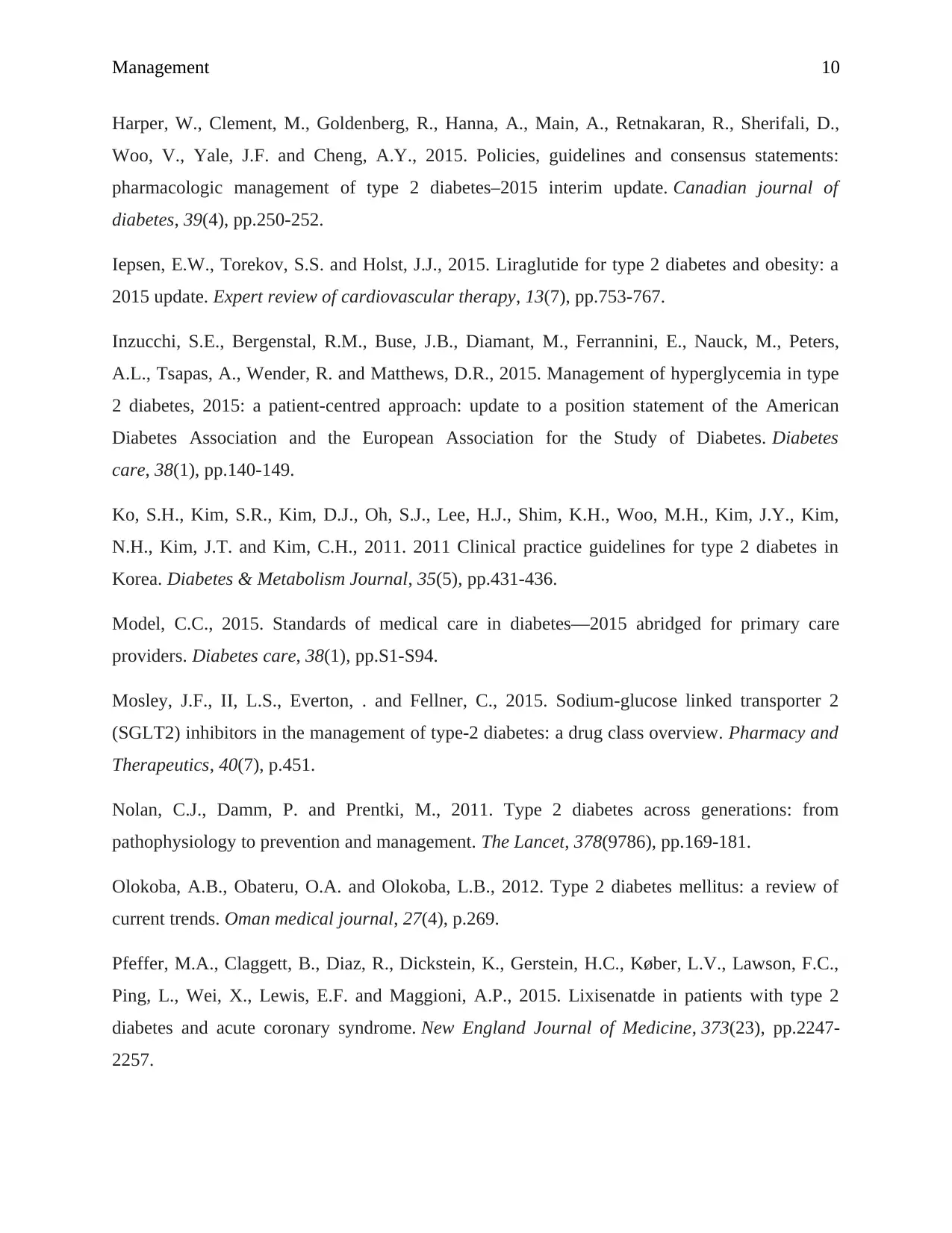
Management 10
Harper, W., Clement, M., Goldenberg, R., Hanna, A., Main, A., Retnakaran, R., Sherifali, D.,
Woo, V., Yale, J.F. and Cheng, A.Y., 2015. Policies, guidelines and consensus statements:
pharmacologic management of type 2 diabetes–2015 interim update. Canadian journal of
diabetes, 39(4), pp.250-252.
Iepsen, E.W., Torekov, S.S. and Holst, J.J., 2015. Liraglutide for type 2 diabetes and obesity: a
2015 update. Expert review of cardiovascular therapy, 13(7), pp.753-767.
Inzucchi, S.E., Bergenstal, R.M., Buse, J.B., Diamant, M., Ferrannini, E., Nauck, M., Peters,
A.L., Tsapas, A., Wender, R. and Matthews, D.R., 2015. Management of hyperglycemia in type
2 diabetes, 2015: a patient-centred approach: update to a position statement of the American
Diabetes Association and the European Association for the Study of Diabetes. Diabetes
care, 38(1), pp.140-149.
Ko, S.H., Kim, S.R., Kim, D.J., Oh, S.J., Lee, H.J., Shim, K.H., Woo, M.H., Kim, J.Y., Kim,
N.H., Kim, J.T. and Kim, C.H., 2011. 2011 Clinical practice guidelines for type 2 diabetes in
Korea. Diabetes & Metabolism Journal, 35(5), pp.431-436.
Model, C.C., 2015. Standards of medical care in diabetes—2015 abridged for primary care
providers. Diabetes care, 38(1), pp.S1-S94.
Mosley, J.F., II, L.S., Everton, . and Fellner, C., 2015. Sodium-glucose linked transporter 2
(SGLT2) inhibitors in the management of type-2 diabetes: a drug class overview. Pharmacy and
Therapeutics, 40(7), p.451.
Nolan, C.J., Damm, P. and Prentki, M., 2011. Type 2 diabetes across generations: from
pathophysiology to prevention and management. The Lancet, 378(9786), pp.169-181.
Olokoba, A.B., Obateru, O.A. and Olokoba, L.B., 2012. Type 2 diabetes mellitus: a review of
current trends. Oman medical journal, 27(4), p.269.
Pfeffer, M.A., Claggett, B., Diaz, R., Dickstein, K., Gerstein, H.C., Køber, L.V., Lawson, F.C.,
Ping, L., Wei, X., Lewis, E.F. and Maggioni, A.P., 2015. Lixisenatde in patients with type 2
diabetes and acute coronary syndrome. New England Journal of Medicine, 373(23), pp.2247-
2257.
Harper, W., Clement, M., Goldenberg, R., Hanna, A., Main, A., Retnakaran, R., Sherifali, D.,
Woo, V., Yale, J.F. and Cheng, A.Y., 2015. Policies, guidelines and consensus statements:
pharmacologic management of type 2 diabetes–2015 interim update. Canadian journal of
diabetes, 39(4), pp.250-252.
Iepsen, E.W., Torekov, S.S. and Holst, J.J., 2015. Liraglutide for type 2 diabetes and obesity: a
2015 update. Expert review of cardiovascular therapy, 13(7), pp.753-767.
Inzucchi, S.E., Bergenstal, R.M., Buse, J.B., Diamant, M., Ferrannini, E., Nauck, M., Peters,
A.L., Tsapas, A., Wender, R. and Matthews, D.R., 2015. Management of hyperglycemia in type
2 diabetes, 2015: a patient-centred approach: update to a position statement of the American
Diabetes Association and the European Association for the Study of Diabetes. Diabetes
care, 38(1), pp.140-149.
Ko, S.H., Kim, S.R., Kim, D.J., Oh, S.J., Lee, H.J., Shim, K.H., Woo, M.H., Kim, J.Y., Kim,
N.H., Kim, J.T. and Kim, C.H., 2011. 2011 Clinical practice guidelines for type 2 diabetes in
Korea. Diabetes & Metabolism Journal, 35(5), pp.431-436.
Model, C.C., 2015. Standards of medical care in diabetes—2015 abridged for primary care
providers. Diabetes care, 38(1), pp.S1-S94.
Mosley, J.F., II, L.S., Everton, . and Fellner, C., 2015. Sodium-glucose linked transporter 2
(SGLT2) inhibitors in the management of type-2 diabetes: a drug class overview. Pharmacy and
Therapeutics, 40(7), p.451.
Nolan, C.J., Damm, P. and Prentki, M., 2011. Type 2 diabetes across generations: from
pathophysiology to prevention and management. The Lancet, 378(9786), pp.169-181.
Olokoba, A.B., Obateru, O.A. and Olokoba, L.B., 2012. Type 2 diabetes mellitus: a review of
current trends. Oman medical journal, 27(4), p.269.
Pfeffer, M.A., Claggett, B., Diaz, R., Dickstein, K., Gerstein, H.C., Køber, L.V., Lawson, F.C.,
Ping, L., Wei, X., Lewis, E.F. and Maggioni, A.P., 2015. Lixisenatde in patients with type 2
diabetes and acute coronary syndrome. New England Journal of Medicine, 373(23), pp.2247-
2257.
Paraphrase This Document
Need a fresh take? Get an instant paraphrase of this document with our AI Paraphraser
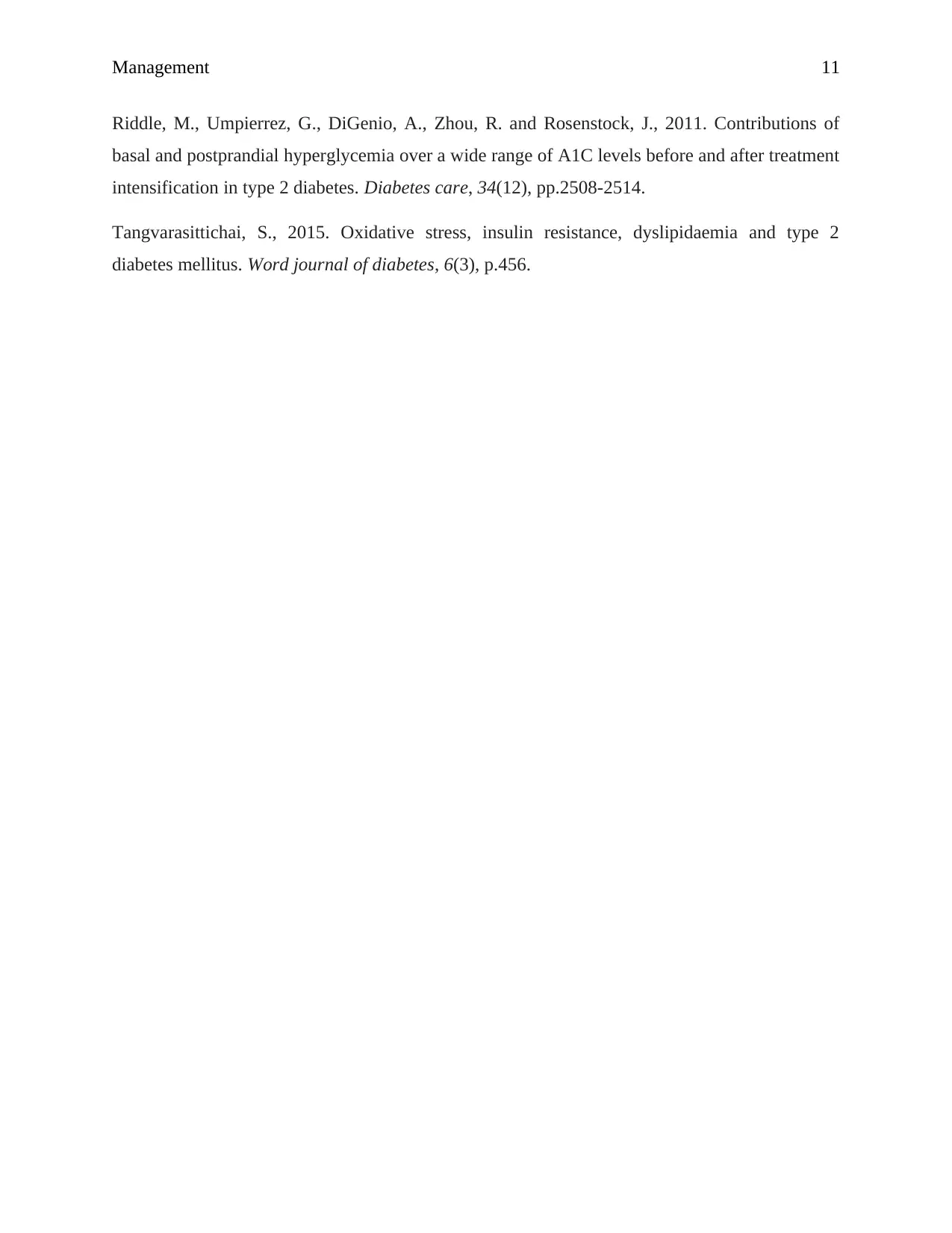
Management 11
Riddle, M., Umpierrez, G., DiGenio, A., Zhou, R. and Rosenstock, J., 2011. Contributions of
basal and postprandial hyperglycemia over a wide range of A1C levels before and after treatment
intensification in type 2 diabetes. Diabetes care, 34(12), pp.2508-2514.
Tangvarasittichai, S., 2015. Oxidative stress, insulin resistance, dyslipidaemia and type 2
diabetes mellitus. Word journal of diabetes, 6(3), p.456.
Riddle, M., Umpierrez, G., DiGenio, A., Zhou, R. and Rosenstock, J., 2011. Contributions of
basal and postprandial hyperglycemia over a wide range of A1C levels before and after treatment
intensification in type 2 diabetes. Diabetes care, 34(12), pp.2508-2514.
Tangvarasittichai, S., 2015. Oxidative stress, insulin resistance, dyslipidaemia and type 2
diabetes mellitus. Word journal of diabetes, 6(3), p.456.
1 out of 11
Related Documents
Your All-in-One AI-Powered Toolkit for Academic Success.
+13062052269
info@desklib.com
Available 24*7 on WhatsApp / Email
![[object Object]](/_next/static/media/star-bottom.7253800d.svg)
Unlock your academic potential
Copyright © 2020–2025 A2Z Services. All Rights Reserved. Developed and managed by ZUCOL.





